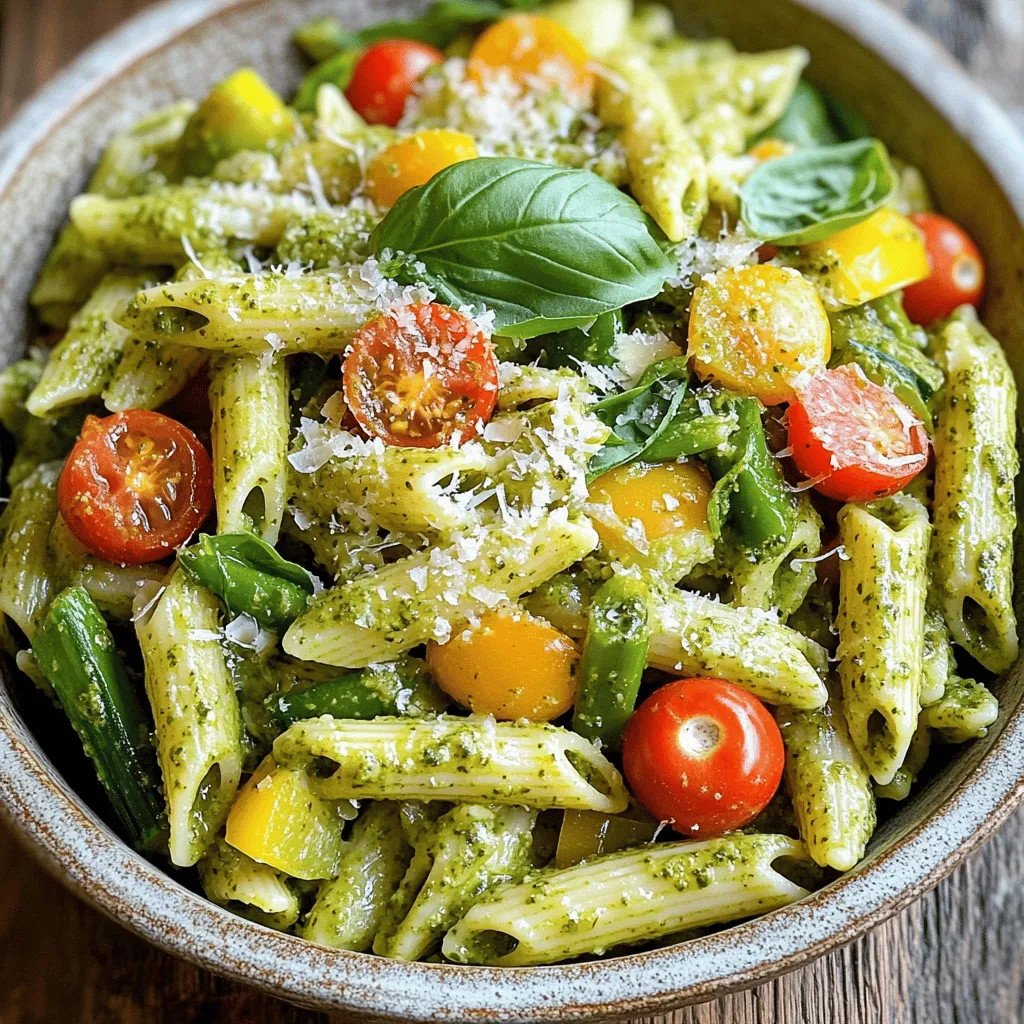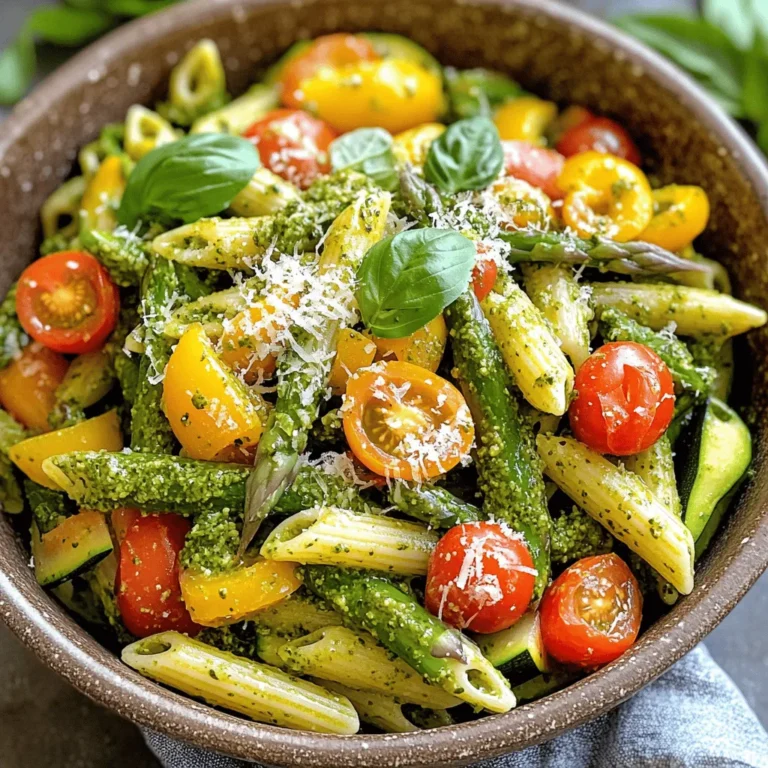Looking for a fresh and tasty meal idea? Pesto Pasta Primavera is perfect for your next dinner. This vibrant dish mixes fresh veggies with penne pasta and flavorful pesto. It’s quick, easy, and satisfying! You can enjoy it as-is or customize it with proteins. Grab your ingredients, and let’s create a colorful meal that is sure to impress your family or guests. Dive in to learn how to make it!
Ingredients
Main Ingredients
– 12 oz penne pasta
– 1 cup cherry tomatoes, halved
– 1 medium zucchini, sliced into half-moons
– 1 red or yellow bell pepper, sliced
– 1 cup asparagus, trimmed and chopped
– 1 cup fresh spinach leaves
– 1/4 cup homemade or store-bought pesto
– 3 tablespoons olive oil
Seasonings and Garnishes
– 2 cloves garlic, minced
– Salt and freshly ground black pepper to taste
– Grated Parmesan cheese (optional, for serving)
– Fresh basil leaves for garnish
When making Pesto Pasta Primavera, I focus on fresh ingredients. You want bright colors and vibrant flavors. The penne pasta is the base of this dish. It holds onto the sauce well. I use cherry tomatoes for a burst of sweetness. Zucchini adds a lovely texture, while bell peppers bring crunch and color. Asparagus gives a nice bite.
Spinach is a must. It wilts down and blends beautifully with the other veggies. For the pesto, I often use homemade, but store-bought works too. Olive oil adds richness and helps sauté the garlic, which brings in a great aroma.
For seasoning, I like to keep it simple. Just salt and freshly ground black pepper will do. You can add grated Parmesan cheese for a creamy touch. Fresh basil leaves brighten the dish and make it look pretty.
This combination of fresh ingredients makes Pesto Pasta Primavera a colorful, healthy meal.
Step-by-Step Instructions
Cooking the Pasta
Fill a large pot with water. Add a generous amount of salt. Bring the water to a boil. Once boiling, add the penne pasta. Cook it until it is al dente, which means firm to the bite. Drain the pasta, but save about half a cup of that starchy water. This water helps the sauce stick later.
Sautéing the Aromatics
In a large skillet, heat three tablespoons of olive oil over medium heat. Add two cloves of minced garlic. Sauté for about 30 seconds. You want the garlic fragrant but not burnt. This step adds a lovely layer of flavor.
Cooking the Vegetables
Now, add one cup of halved cherry tomatoes, one medium sliced zucchini, one sliced red or yellow bell pepper, and one cup of chopped asparagus. Sauté these vegetables for about five to seven minutes. You want them tender but still crisp. This mix brings freshness and color to the dish.
Finishing the Dish
Next, stir in one cup of fresh spinach. Cook until the spinach wilts, which takes about two minutes. Then, combine the drained pasta with the vegetables in the skillet. Pour in the reserved pasta water and a quarter cup of pesto. Toss it all together so that each piece of pasta is coated. Taste and season with salt and pepper based on your preference. Serve hot, and for a finishing touch, sprinkle with grated Parmesan cheese, if you like. For the final flair, add some fresh basil leaves for garnish.Enjoy your Pesto Pasta Primavera!
Tips & Tricks
Cooking Tips
– How to achieve the perfect al dente pasta: Start by boiling a large pot of salted water. Add your penne pasta when the water is at a full boil. Cook it according to the package instructions. Check it a minute early. You want it firm but cooked through. Drain it but save some pasta water. This water helps make the sauce creamy.
– Tips for sautéing vegetables to maintain crunch: Use a large skillet and medium heat. Heat your olive oil first. Add your minced garlic and cook for about 30 seconds. Then, add the chopped vegetables, like zucchini and bell pepper. Sauté them for 5-7 minutes. You want them tender but still crisp. Stir them often so they cook evenly.
Pesto Tips
– Using homemade vs. store-bought pesto: Homemade pesto tastes fresh and bright. It uses basil, garlic, nuts, and olive oil. If you’re short on time, store-bought pesto works well too. Just check the label for quality ingredients. Both options will give your pasta flavor.
– How to adapt pesto for different flavor profiles: You can change the nuts in the pesto to walnuts or almonds. Try adding different herbs, like arugula or parsley, for a twist. For a spicy kick, toss in some red pepper flakes. The goal is to make it your own.
Serving Suggestions
– Ideal serving temperature and presentation tips: Serve your Pesto Pasta Primavera hot. Use shallow bowls for a nice look. Drizzle extra pesto on top for color. Add a few halved cherry tomatoes for a pop. Fresh basil leaves make it look even better.
– Best wine pairings for Pesto Pasta Primavera: A crisp white wine pairs well. Look for a Sauvignon Blanc or a Pinot Grigio. These wines won’t overpower the fresh flavors. If you prefer red, a light Chianti could work nicely too.

Variations
Ingredient Substitutions
You can switch up the pasta for different diets. Try gluten-free pasta if needed. Whole grain pasta adds fiber and a nutty taste. You can also change the veggies based on what’s in season. Try using broccoli, carrots, or snap peas for a fresh twist.
Protein Additions
For a heartier meal, add chicken or shrimp. Simply cook them before you sauté the veggies. Toss them in with the pasta and pesto. If you’re vegetarian, consider tofu or chickpeas. Both options add protein and work well with the dish’s flavors.
Dietary Modifications
You can easily make this dish vegan or dairy-free. Just skip the cheese and use a vegan pesto. For those on a low-carb diet, use zucchini noodles instead of pasta. This keeps the flavors rich while cutting carbs. Enjoy experimenting with these options to find your favorite!
Storage Info
Refrigeration Guidelines
To keep your Pesto Pasta Primavera fresh, store leftovers in an airtight container. Make sure to cool the pasta to room temperature first. Place it in the fridge within two hours of cooking. This dish will stay good for up to three days. When you are ready to eat, reheat it gently. Use a pan over low heat to warm it up. Add a splash of water or extra olive oil to keep it moist.
Freezing Instructions
If you want to save some for later, freezing is a great option. First, let the pasta cool completely. Then, divide it into single-serving portions. Place these portions in freezer-safe bags or containers. Remove as much air as possible before sealing. Your pasta will freeze well for up to three months.
When you’re ready to enjoy it, take the pasta out of the freezer. Thaw it overnight in the fridge. For reheating, place it in a skillet over medium heat. Add a little water or olive oil to help it heat evenly. Stir frequently until it’s hot and ready to serve.
FAQs
How long does Pesto Pasta Primavera last in the fridge?
Pesto Pasta Primavera can last up to three days in the fridge. Store it in an airtight container. Make sure to let it cool before sealing to avoid excess moisture.
Can I make this recipe ahead of time?
Yes, you can make Pesto Pasta Primavera ahead of time. Prepare the pasta and veggies, then mix in the pesto just before serving. This keeps the flavors fresh.
What are some good side dishes to serve with pesto pasta?
Good side dishes include garlic bread, a fresh salad, or roasted vegetables. These sides add variety and enhance your meal.
How spicy is pesto and can I adjust it?
Pesto is usually mild. If you want more heat, add red pepper flakes or a dash of hot sauce. Adjust to your taste for a better kick.
This blog post covered a simple and tasty Pesto Pasta Primavera recipe. You learned about key ingredients, cooking steps, and helpful tips. I shared ideas for variations, storage, and answers to common questions.
By trying this dish, you can enjoy a colorful, nutritious meal that fits many diets. Use the tips and substitutions to make it your own. Cooking is fun and lets you explore new flavors. Enjoy creating your pasta masterpiece!


